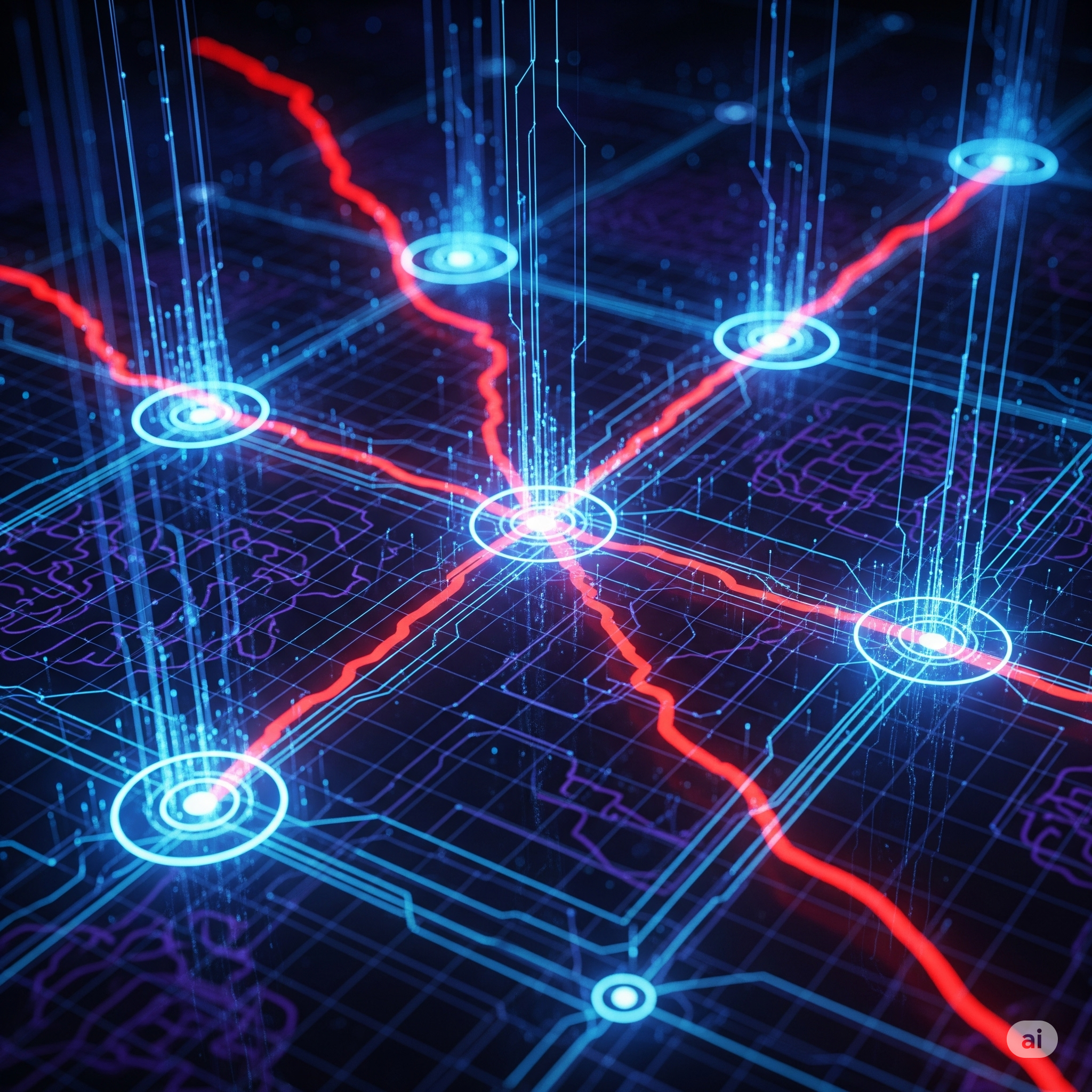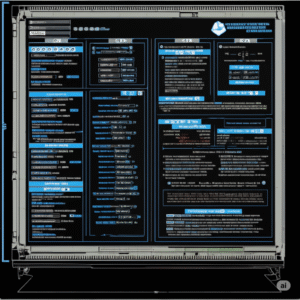In today’s hyper-connected world, the question is no longer if your business will face a cyber attack, but when. Traditional security measures, like firewalls and antivirus software, were built for a simpler time. They operate like a security guard with a list of known troublemakers; if someone isn’t on the list, they might just walk right in. This reactive approach is dangerously outdated against modern threats that are sophisticated, automated, and evolve in the blink of an eye. This is where AI network security changes the game entirely.
Imagine upgrading that security guard to a team of predictive analysts who can spot suspicious behavior, understand subtle tells, and neutralize a threat before it ever breaches the door. That’s the power of artificial intelligence in cybersecurity. It’s not just a buzzword; it’s a fundamental shift from a defensive posture to a proactive, intelligent defense mechanism. For businesses looking to not only survive but thrive, understanding and implementing AI network security is becoming non-negotiable. This guide will demystify the technology, explore its practical applications, and show you how to get started.
Why Your Old-School Security Is a Ticking Time Bomb
For years, the foundation of network security rested on signature-based detection. This method works by identifying threats based on their known digital footprints, or “signatures.” While effective against common viruses and known malware from the past, it has a glaring weakness: it cannot detect what it has never seen before. Cybercriminals are innovating at a blistering pace, launching “zero-day” attacks and polymorphic malware that constantly change their code to evade detection.
Trying to keep up with manual updates and signature lists is like trying to patch a sinking ship with duct tape. The sheer volume of data and alerts generated by a modern business network is overwhelming for human security teams. A study by McKinsey highlights the escalating financial and operational risks, emphasizing that legacy systems are ill-equipped to handle the scale and sophistication of current cyber threats. This leads to “alert fatigue,” where overworked analysts begin to miss the critical threats buried under a mountain of false positives. This is precisely the gap that AI network security is designed to fill.
What Exactly Is AI Network Security? A Smarter Approach to Defense
At its core, AI network security leverages machine learning (ML) and deep learning (DL) algorithms to analyze your network’s data in real time. Instead of just looking for known bad guys, it learns what “normal” looks like for your specific network. It establishes a baseline of typical user behavior, data flow, and device communication. Any deviation from this baseline is immediately flagged as a potential threat, whether it’s a known virus or a brand-new, never-before-seen attack vector.
Think of it as the difference between a simple smoke detector and a comprehensive building management system. A smoke detector only screams when it sees smoke (a known signature). The intelligent system, however, monitors air quality, temperature fluctuations, and unusual electrical draws, allowing it to predict a fire hazard long before any smoke appears. This predictive capability is the cornerstone of cyber defense AI, transforming it from a reactive tool into a predictive and autonomous guardian for your digital assets.
The Core Capabilities of an AI Network Security System
The power of AI network security isn’t a single feature but a combination of intelligent capabilities working in concert. These systems are designed to think, learn, and act with a speed and scale that is humanly impossible, providing a multi-layered defense.
Here are the key functions that make it so effective:
- Predictive Threat Analytics: AI algorithms analyze vast datasets from global threat intelligence feeds and your internal network traffic. By identifying patterns and correlating seemingly unrelated events, the AI can predict potential attacks and identify emerging threats before they are widely known, allowing you to patch vulnerabilities proactively.
- Intelligent Behavioral Analysis (UEBA): User and Entity Behavior Analytics (UEBA) is a critical component. The AI learns the unique habits of every user and device on your network. Does an employee in accounting suddenly try to access sensitive engineering files at 3 AM from an unrecognized location? AI flags this anomalous behavior instantly, which a signature-based system would completely miss.
- Automated Incident Response: When a credible threat is detected, time is of the essence. AI network security platforms can automate the response process. This could involve quarantining an infected device, blocking a malicious IP address, or terminating a suspicious process—all happening in milliseconds, drastically reducing the window of opportunity for an attacker to inflict damage.
Case Study 1: How a FinTech Firm Prevented a Multi-Million Dollar Breach with AI
A mid-sized financial technology firm, “AlphaVest,” was facing a deluge of sophisticated phishing attempts. Their security team was stretched thin, and a single successful breach could erode client trust and incur massive financial losses. They implemented an AI network security solution to augment their existing defenses. Within weeks, the AI established a baseline of normal employee communication and data access patterns.
One afternoon, the system detected a highly unusual activity: an accountant’s credentials were used to attempt a data exfiltration request to an unknown server in Eastern Europe. The request was small and designed to fly under the radar of traditional volume-based alerts. However, the cyber defense AI flagged it immediately because a) the user had never connected to a server in that region, and b) the type of data packet was inconsistent with their normal duties. The AI automatically locked the account and quarantined the user’s machine, alerting the security team. An investigation revealed a highly targeted spear-phishing attack had compromised the credentials. The AI’s rapid, automated response prevented what could have been a devastating data breach.
Top AI Tools Powering Modern Cyber Defense AI
Adopting AI network security doesn’t always mean ripping and replacing your entire infrastructure. Many powerful tools can integrate with your existing setup to provide next-generation capabilities.
Here are a few industry-leading platforms:
- Darktrace (The Enterprise Immune System): Often considered a pioneer in the space, Darktrace uses self-learning AI to model the “pattern of life” for every user and device in a network. It excels at detecting insider threats and subtle, slow-moving attacks that other tools miss.
- Website: https://www.darktrace.com/
- Microsoft Sentinel: For businesses already invested in the Microsoft ecosystem, Sentinel is a powerful cloud-native SIEM (Security Information and Event Management) and SOAR (Security Orchestration, Automation, and Response) solution. It uses built-in AI to collect and analyze data at cloud scale, helping you see the full picture and automate responses.
- Vectra AI: Vectra focuses on automating threat detection and response from cloud and data center workloads to user and IoT devices. It prioritizes threats based on risk scores, helping security teams focus on what matters most and avoid alert fatigue.
- Website: https://www.vectra.ai/
Case Study 2: E-commerce SMB Secures Customer Data with Cyber Defense AI
“BloomBox,” a fast-growing online flower delivery service, experienced a surge in traffic during a holiday season, which also attracted attackers. They were hit with a Distributed Denial of Service (DDoS) attack that overwhelmed their website, causing significant revenue loss. Realizing their basic firewall was insufficient, they adopted a cloud-based AI network security provider.
The AI immediately began analyzing their traffic patterns. When a second, more sophisticated DDoS attack was launched a month later, the system recognized the malicious traffic signature instantly. Instead of simply blocking all traffic and shutting down the site, the AI intelligently filtered out the malicious requests while allowing legitimate customer traffic to pass through. The website remained online and fully functional during the attack. The AI also identified the botnet’s source IPs and automatically updated firewall rules to block them permanently, strengthening the company’s overall cyber defense AI posture.
Getting Started with AI Network Security: A Beginner’s Workflow
Integrating AI into your security strategy may sound daunting, but it can be approached in manageable steps. You don’t need a team of data scientists to begin leveraging the benefits of AI network security.
Your Vacation Won’t Be Ruined By a Broken AC. Here’s Why.
Step 1: Assess and Identify Your Crown Jewels
Before you buy any tool, understand what you need to protect most. Is it customer PII (Personally Identifiable Information)? Is it proprietary intellectual property? Or is it ensuring operational uptime? Knowing your critical assets will help you choose a solution tailored to your biggest risks.
Step 2: Start with a Pilot Project
You don’t have to boil the ocean. Begin with a specific, high-impact area. A great place to start is with a UEBA tool to monitor for insider threats or compromised credentials, as this often represents the greatest vulnerability for many organizations. This allows you to demonstrate value quickly and secure buy-in for a broader rollout.
Step 3: Prioritize Integration and Automation
Choose an AI solution that integrates well with your existing security stack (firewalls, endpoint protection, etc.). The goal is to create a unified system where the AI acts as the central brain. As you gain confidence, start enabling automated response features. Begin with low-risk automations, like alerting security personnel, and gradually move towards more active responses like quarantining devices. As OpenAI continues to develop more sophisticated models, the potential for intelligent, context-aware automation will only grow.
Step 4: Train Your Team and Refine
An AI tool is only as good as the team managing it. Your security personnel need to understand how to interpret the AI’s findings and work with the system, not against it. Invest in training and establish clear protocols for handling AI-flagged incidents. Continuously review the AI’s performance and fine-tune its parameters to reduce false positives and improve its accuracy over time.
The Future is Autonomous: What’s Next for AI Network Security?
The evolution of AI network security is far from over. We are moving towards a future of fully autonomous security systems. Generative AI, the same technology powering models like ChatGPT, is poised to create “self-healing” networks that can not only detect and respond to threats but also predict and patch vulnerabilities before they can be exploited. This ongoing cat-and-mouse game between attackers and defenders will be increasingly fought by competing AIs.
For businesses, this means that embracing AI network security is not just an investment in protection—it’s an investment in resilience, continuity, and a competitive edge. The threats will only get smarter, faster, and more relentless. Your defense must do the same. By shifting from a reactive to a predictive and automated security model, you can free up your human experts to focus on strategic initiatives, confident that your network has an intelligent, sleepless guardian watching over it 24/7.
Hotel Prices Just Changed Again! The AI Behind Travel Costs.



